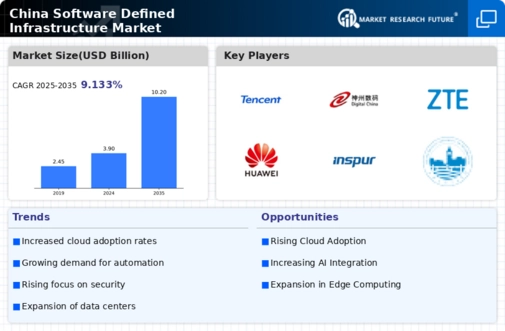Shift Towards Edge Computing
The software defined-infrastructure market in China is witnessing a significant shift towards edge computing. As the demand for real-time data processing and low-latency applications grows, businesses are increasingly adopting edge solutions to enhance their operational capabilities. This transition is particularly relevant in industries such as manufacturing and smart cities, where immediate data analysis is crucial. Recent statistics suggest that the edge computing segment within the software defined-infrastructure market is expected to expand by over 40% in the next few years. This growth is driven by the need for localized data processing, which reduces latency and improves overall system performance. Consequently, companies are investing in software defined technologies that facilitate edge computing, thereby reshaping the infrastructure landscape in China.
Rising Demand for Scalability
The software defined-infrastructure market in China is experiencing a notable surge in demand for scalable solutions. As enterprises increasingly seek to enhance their operational efficiency, the ability to scale resources dynamically becomes paramount. This trend is particularly evident in sectors such as e-commerce and telecommunications, where fluctuating workloads necessitate flexible infrastructure. According to recent data, the market for scalable software defined solutions is projected to grow by approximately 25% annually. This growth is driven by the need for businesses to adapt quickly to changing market conditions while minimizing costs. Consequently, vendors are focusing on developing innovative solutions that allow for seamless scaling, thereby positioning themselves favorably within the software defined-infrastructure market. The emphasis on scalability is likely to continue shaping the competitive landscape in the coming years.
Government Initiatives and Support
In China, government initiatives aimed at promoting digital transformation are significantly influencing the software defined-infrastructure market. The Chinese government has launched various programs to encourage the adoption of advanced technologies, including software defined solutions. These initiatives often include financial incentives, tax breaks, and grants for companies investing in digital infrastructure. As a result, many organizations are increasingly integrating software defined technologies into their operations to align with national strategies. Recent reports indicate that government support has led to a 30% increase in investments in software defined infrastructure over the past year. This trend is expected to continue, as the government remains committed to fostering innovation and enhancing the country's technological capabilities, thereby driving growth in the software defined-infrastructure market.
Growing Importance of Data Security
Data security is becoming an increasingly vital concern within the software defined-infrastructure market in China. As cyber threats evolve and data breaches become more frequent, organizations are compelled to adopt robust security measures. The software defined approach offers enhanced security features, such as automated threat detection and response capabilities. Recent surveys indicate that approximately 70% of enterprises in China consider security a top priority when selecting software defined solutions. This heightened focus on security is driving demand for solutions that integrate advanced security protocols and compliance measures. Consequently, vendors are investing in developing software defined technologies that not only meet performance requirements but also address security challenges. The growing importance of data security is likely to shape the future landscape of the software defined-infrastructure market.
Increased Focus on Energy Efficiency
Energy efficiency has emerged as a critical driver in the software defined-infrastructure market in China. With rising energy costs and growing environmental concerns, organizations are increasingly prioritizing energy-efficient solutions. The software defined approach allows for better resource management and optimization, leading to reduced energy consumption. Recent analyses indicate that companies adopting energy-efficient software defined technologies can achieve up to 20% savings on their energy bills. This trend is particularly pronounced in data centers, where energy consumption is a significant operational expense. As a result, vendors are developing solutions that not only enhance performance but also minimize energy usage, thereby appealing to environmentally conscious consumers. The emphasis on energy efficiency is likely to continue influencing purchasing decisions within the software defined-infrastructure market.

















Leave a Comment